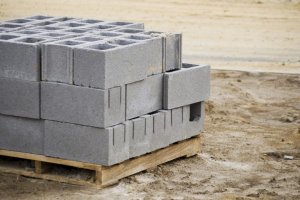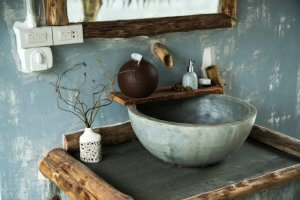Reinforced Concrete: Properties, Uses, and Maintenance

Reinforced concrete is the most common material in construction. But it has recently become a trend in interior and exterior home decoration. Its durability and appearance have taken it from being a basic construction material to an elegant decor option.
First, we’re going to tell you some of its main properties. Then we’ll tell you what kinds of things you can use this durable material for. Lastly, we’ll show you how to maintain it if you decide to use it for your home.

Reinforced concrete: everything you need to know
Properties
Reinforced concrete is made out of cement, stone chips, sand, and water. One thing that really makes it stand out is that it also has steel rods in the middle. This combination of materials makes reinforced concrete one of the strongest, most weight-resistant construction materials.
The steel is what sets it apart from regular concrete, it’s where the “reinforced” part comes from. This means it’s also much tougher than traditional concrete.
Reinforced concrete is malleable, adaptable, and can fit in easily with other materials. It can handle lots of weight, energy, and pressure. So, it’s always a good option if you’re building a new house. If you aren’t convinced yet, it’s also highly durable, which makes it even more special.

Uses
This material is most common in houses and large buildings, though you’ll also see it in bridges and tunnels. It’s less common in houses, but reinforced concrete is starting to become a trend for interior decorating as well. Using it for walls, floors, or ceilings and leaving it exposed gives a nice, original touch to a room.
Interiors
Reinforced concrete is very popular right now for countertops, furniture, and dividing walls. It’s very characteristic of homes done in an industrial style and huge lofts.
You can leave it as it’s original color or paint it a kind of worn-down white, for example. It’s also common to see concrete walls shaped by square panels.
If you want to have exposed concrete in your home, we suggest you combine it with warm colors and materials. Wood and neutral tones are especially good for this. They’ll help balance your spaces, because concrete is a “cold” material.

Exteriors
You can also use reinforced concrete for your home exterior. Grills, columns, and patio floors are all possibilities with concrete. It’s a wonderful alternative if you’re looking for tough exterior materials.
You can even make benches and tables out of it. They look great in concrete and will be able to handle any climate. Try putting some concrete furniture in your garden or on the patio, and see how beautiful it looks!
Maintenance

Reinforced concrete doesn’t take much maintenance once installed. But, while it’s in the construction phase, you need to make sure it gets “cured.” In other words, once the concrete has been placed and finished, it still needs 5-7 more days to dry and set properly.
Otherwise, it could lose some of its durability and start to crack and break not long after you install it. One thing you need to do is cover it with damp fabrics during this process. This will help the concrete harden properly and keep it from falling apart later on.
As you can see, reinforced concrete is a tough, practical building material. It’s just as viable for big construction projects and major home structures as it is for interior decorating and accessories. Plus, because it’s such a common building material, it’s not wildly expensive.
So, you could try using reinforced concrete to decorate your walls, build beautiful furniture, or even just for columns or decorative accessories. Choose this fascinating material for your home, and you won’t be disappointed!
Reinforced concrete is the most common material in construction. But it has recently become a trend in interior and exterior home decoration. Its durability and appearance have taken it from being a basic construction material to an elegant decor option.
First, we’re going to tell you some of its main properties. Then we’ll tell you what kinds of things you can use this durable material for. Lastly, we’ll show you how to maintain it if you decide to use it for your home.

Reinforced concrete: everything you need to know
Properties
Reinforced concrete is made out of cement, stone chips, sand, and water. One thing that really makes it stand out is that it also has steel rods in the middle. This combination of materials makes reinforced concrete one of the strongest, most weight-resistant construction materials.
The steel is what sets it apart from regular concrete, it’s where the “reinforced” part comes from. This means it’s also much tougher than traditional concrete.
Reinforced concrete is malleable, adaptable, and can fit in easily with other materials. It can handle lots of weight, energy, and pressure. So, it’s always a good option if you’re building a new house. If you aren’t convinced yet, it’s also highly durable, which makes it even more special.

Uses
This material is most common in houses and large buildings, though you’ll also see it in bridges and tunnels. It’s less common in houses, but reinforced concrete is starting to become a trend for interior decorating as well. Using it for walls, floors, or ceilings and leaving it exposed gives a nice, original touch to a room.
Interiors
Reinforced concrete is very popular right now for countertops, furniture, and dividing walls. It’s very characteristic of homes done in an industrial style and huge lofts.
You can leave it as it’s original color or paint it a kind of worn-down white, for example. It’s also common to see concrete walls shaped by square panels.
If you want to have exposed concrete in your home, we suggest you combine it with warm colors and materials. Wood and neutral tones are especially good for this. They’ll help balance your spaces, because concrete is a “cold” material.

Exteriors
You can also use reinforced concrete for your home exterior. Grills, columns, and patio floors are all possibilities with concrete. It’s a wonderful alternative if you’re looking for tough exterior materials.
You can even make benches and tables out of it. They look great in concrete and will be able to handle any climate. Try putting some concrete furniture in your garden or on the patio, and see how beautiful it looks!
Maintenance

Reinforced concrete doesn’t take much maintenance once installed. But, while it’s in the construction phase, you need to make sure it gets “cured.” In other words, once the concrete has been placed and finished, it still needs 5-7 more days to dry and set properly.
Otherwise, it could lose some of its durability and start to crack and break not long after you install it. One thing you need to do is cover it with damp fabrics during this process. This will help the concrete harden properly and keep it from falling apart later on.
As you can see, reinforced concrete is a tough, practical building material. It’s just as viable for big construction projects and major home structures as it is for interior decorating and accessories. Plus, because it’s such a common building material, it’s not wildly expensive.
So, you could try using reinforced concrete to decorate your walls, build beautiful furniture, or even just for columns or decorative accessories. Choose this fascinating material for your home, and you won’t be disappointed!
All cited sources were thoroughly reviewed by our team to ensure their quality, reliability, currency, and validity. The bibliography of this article was considered reliable and of academic or scientific accuracy.







